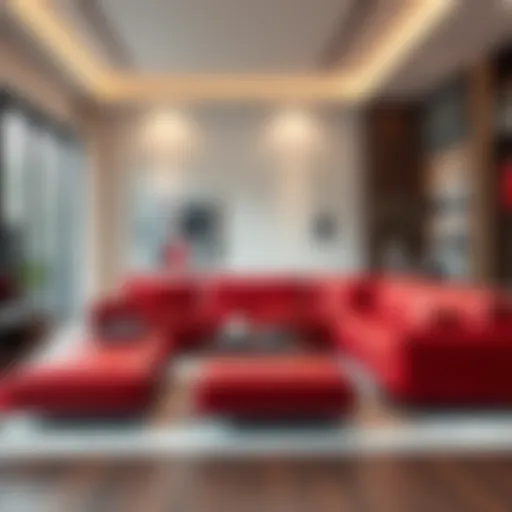Reflections of Design: The Function of Mirrors in Interiors
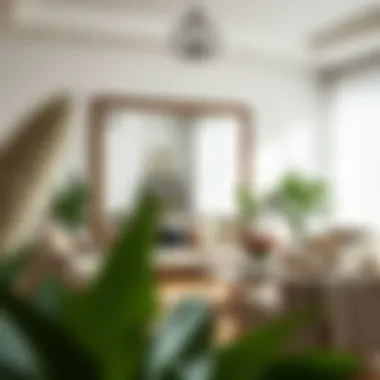

Intro
Mirrors, often considered mere decorative objects, hold a much richer significance in the world of interior design. These reflective surfaces offer a myriad of functionalities that go beyond simple aesthetics. Their presence can transform a room, creating an illusion of spaciousness, amplifying natural light, or even serving as a compelling focal point. The right mirror can elevate the atmosphere of a space, imbuing it with character and charm.
In this exploration, we unwrap the layers of design that come into play when incorporating mirrors into interior spaces. Whether you are a homeowner seeking to refresh your living area or a design professional scouting for inspiration, understanding the dynamic role of mirrors can enhance both utility and beauty within any environment.
Furniture Trends
Current Design Trends
As we stride into modernity, mirror design is experiencing a renaissance. No longer relegated to conventional framing, mirrors now come in an array of shapes, sizes, and styles. From minimalist geometric forms to ornate art deco pieces, the market reflects a growing desire for individuality. Designers tend to play with unconventional placements, mounting mirrors on ceilings or using them in unexpected locales, like corridors or dining spaces.
The shift toward open-concept living has also fueled the innovative use of mirrors. With such layouts often requiring clever tricks to delineate spaces without physical barriers, mirrors can act as visual dividers while maintaining fluidity. Here’s how current trends are evolving:
- Biophilic Design: Mirrors are being used to reflect nature, creating harmony inside by mirroring views of gardens and outdoor spaces.
- Layered Textures: Pairing mirrors with varied surface finishes, like wood, metal, or textiles, adds depth and dimension.
- Mood Lighting: Backlit mirrors are gaining popularity, providing ambient illumination that enhances the charm of bathrooms or entryways.
Popular Color Palettes
When we talk about color, mirrors don't just reflect; they can harmonize or contrast with their surroundings. The trend leans towards softer palettes that promote tranquility, such as pastels, whites, and muted earth tones. A sage green wall behind a sleek gold-framed mirror offers a delicate yet stylish statement. Meanwhile, bold colors, such as deep navy or striking plum, can be beautifully juxtaposed with metallic mirrors, drawing the eye and making a stunning declaration of style.
Some popular combinations include:
- Soft greys with silver or mirrored finishes
- Warm terracotta walls with antique gold mirrors
- Cool blues paired with matte black frames
Practical Tips
Effective Mirror Placement
Finding the right spot for a mirror can be the difference between a room that feels open and airy or one that feels constricted. Here’s how to maximize the benefits of mirrors in various settings:
- Entryways: A large mirror can visually expand a cramped hallway while providing a space for last-minute checks before heading out.
- Living Rooms: Placing a mirror across from a window increases natural light and enhances the feeling of openness.
- Bedrooms: Reflections should be considered carefully; placing mirrors to reflect peaceful views can promote serenity, while avoiding reflections that can create unease.
Maintenance Tips
Mirrors require thoughtful care to keep them looking their best. Avoid abrasive cleaners that can scratch the surface. Instead:
- Use a mixture of water and vinegar for a streak-free shine.
- Soft microfiber cloths are best for a gentle touch.
The elegance of mirrors is elemental in modern interior design; they do much more than adorn walls. They act as multipliers of light and space while adding personal flair that tells a story. Now, as you dive deeper into the unique ways to wield mirrors in your own home or design projects, let these insights guide you in harnessing their full potential to create stunning environments.
Prolusion to Mirrors in Interior Design
Mirrors have served a significant role in the landscape of interior design. They are more than just functional objects; they act as a canvas for creativity and a tool for enhancing spatial dynamics. The moment you set foot in a room, the presence of a mirror often dictates the atmosphere, merging practicality with artistry. By reflecting light and images, mirrors can fundamentally alter how one perceives a space. In a world where aesthetics and functionality walk hand in hand, understanding the impact of mirrors becomes crucial for homeowners and designers alike.
Moreover, mirrors can lend a unique character to various interior styles, seamlessly integrating with modern and traditional designs. Their versatility speaks volumes. Whether one opts for a minimalist round mirror in a Nordic setting or a lavish ornate piece in a Victorian-styled home, the choices are abundant.
Historical Overview of Mirrors
Mirrors trace their origins back to ancient civilizations. The earliest mirrors were crafted from polished stone or metal. For instance, the Egyptians utilized obsidian, while the Greeks favored polished bronze. Such mirrors, albeit rudimentary, provided a glimpse into one's reflection and were often more prized for decorative purposes rather than practical use.
In the Middle Ages, glass-making techniques advanced, allowing for the creation of mirrors that were more accessible to the public. This innovation marked a turning point, enabling wider usage in homes and public spaces, thus embedding the mirror deeper into societal routines.
The craft really took off during the Renaissance, particularly in Venice, where mirrors became luxurious, intricate pieces synonymous with wealth and nobility. This refinement of mirrors showcased the artistry that could mirror one’s soul, quite literally. Today, while mirrors have evolved in style and functionality, their historical context reminds us of the crucial part they play in our lives, beyond merely reflecting our images.
The Psychology of Reflection
The act of looking into a mirror goes beyond vanity; it taps deep into human psychology. Mirrors possess an intriguing ability to enhance one's self-image, triggering feelings of confidence or self-doubt, depending on the viewer’s perspective. Research has indicated that how people react to their reflection can be deeply tied to their self-esteem and identity.
Moreover, mirrors serve as portals, reflecting not just physical appearances but emotional states as well. The effect of light bouncing off a mirror can uplift a mood, creating a brighter ambiance that resonates with positivity. Hence, strategically placed mirrors in a space can foster a warm, welcoming environment, often mentioned in design psychology.
"To design is to communicate clearly by whatever means you can control or master." - Milton Glaser
This insight marries form and function with a psychological bent, suggesting that effective design ought to reflect the inner spirit of those inhabiting the space, making mirrors a vital feature in home décor. By understanding the nuances of mirrors and their historical significance, one is better equipped to use these reflective surfaces to craft individual spaces that resonate with both beauty and function.
The Aesthetic Appeal of Two Mirrors
The integration of multiple mirrors in interior design can elevate a space to new heights of elegance and charm. When utilized correctly, two mirrors can work harmoniously to not just enhance the aesthetics but also bring tangible benefits to the overall environment. The visual dialogue created by positioning two mirrors in relation to one another can amplify the ambiance, creating layers of reflections that dance across surfaces. This article explores why the aesthetic appeal of two mirrors holds significant weight in the realm of interior design, considering elements like visual interest, symmetry, and balance.
Creating Visual Interest
Visually speaking, mirrors are more than just reflective surfaces; they serve as catalysts for deeper engagement within a space. When two mirrors are placed strategically, they create intriguing angles and reflections that draw the eye. This interaction can turn an otherwise plain wall into a dynamic feature that commands attention.
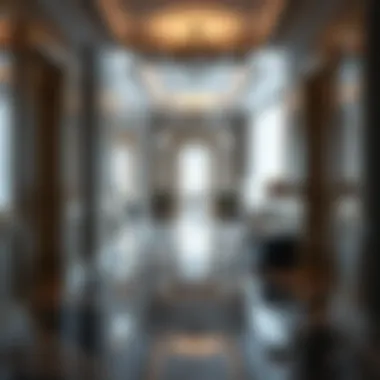
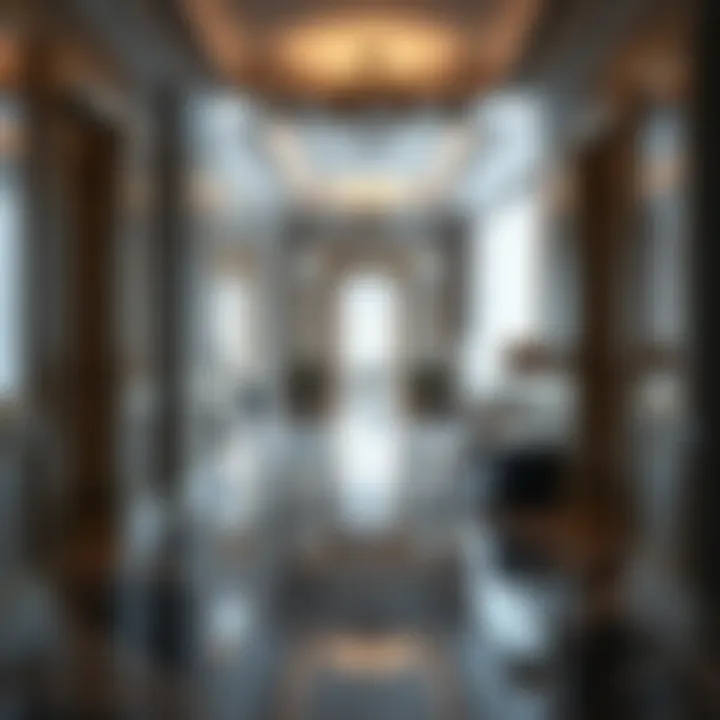
Consider a scenario where one mirror is larger and the second smaller, each displayed at complementary angles. This setup not only captures reflections that will twinkle and sparkle but introduces variety to what would otherwise be a monotonous backdrop. Such practices can be seen commonly in spaces such as boutique hotels or upscale dining establishments, where the goal is to entice and captivate clients.
Furthermore, the surface finish of these mirrors—their frames, textures, and styles—can contribute to a sense of character as well. For example, a vintage mirrored frame juxtaposed with a sleek, modern one can generate a delightful contrast.
- Highlights Depth: The interplay of reflections creates a sense of depth, making spaces feel more expansive.
- Adds Layers: Mirrors can reflect light, colors, and even artwork, creating multi-dimensional focal points.
Symmetry and Balance in Design
Symmetry often plays a key role in achieving balance within interior spaces. When two mirrors are introduced into a design, their placements can establish a sense of symmetry that is pleasing to the eye. This alignment creates an orderly feel that is rooted in aesthetics but also contributes to the functionality of a space.
For instance, placing two matching mirrors on either side of a mantelpiece not only guides the eye through the space but also reinforces a sense of harmony. In balancing reflective surfaces, one can evoke feelings of calm and steadiness; a straightforward concept but one that resonates deeply in design thinking.
Additionally, the balance achieved can transcend just visual appeal. The careful consideration of where mirrors are placed often leads to enhanced spatial flows. Well-positioned mirrors reflect light across a room, subduing harsh shadows and promoting an inviting atmosphere. The connection between symmetry and balance also extends to emotional and psychological realms, implying order and tranquility.
"Symmetry is not the absence of variety; rather, it defines relationships that amplify beauty through balance."
By recognizing the dual role of aesthetic and structural integrity that arises from using two mirrors, designers can craft spaces that resonate more strongly with their inhabitants while providing the additional perk of creating environments that invite exploration and appreciation.
Functional Benefits of Mirrors
Mirrors are more than mere reflective surfaces; they serve various practical purposes that can dramatically enhance the functionality of any interior space. When one considers the incorporation of mirrors in design, the focus often rests on their aesthetic appeal. However, the real magic lies in understanding how mirrors can provide distinct utilitarian advantages that may not be immediately evident. This section breaks down important benefits such as enhancing natural light and creating an illusion of space.
Enhancing Natural Light
Mirrors can amplify the sources of natural light in a room, making it feel brighter and more inviting. By positioning mirrors strategically across from windows, they allow sunlight to bounce around the space, creating a cheerful ambiance. This kind of light amplification doesn’t just brighten the room; it can also contribute to energy savings by reducing the need for artificial lighting during the day.
- Placement Consideration: An ideal spot for mirrors is around entryways, ensuring they reflect light as soon as a guest walks in.
- Texture and Finish: The frame style and surface finish of the mirror can impact how well it reflects light. A sleek and minimalist frame can create a modern look, while a detailed ornate frame can add a touch of vintage charm.
- Layering Light: Use multiple mirrors at varying angles to layer natural light, creating a more dynamic atmosphere.
"A well-placed mirror not only bounces light but also emotions, making spaces feel alive and vibrant."
Creating an Illusion of Space
In smaller areas, mirrors can be a homeowner’s best friend. Their reflective properties create an illusion of depth and expansiveness, making confined areas feel much larger. They can visually extend spaces, eliminating that cramped feeling often found in apartments or smaller homes. The trick lies in how and where you position the mirrors.
- Horizontal vs. Vertical: Horizontal mirrors can widen narrow corridors, while vertical mirrors draw the eye upward, increasing the perception of height in rooms.
- Mirror Size: Larger mirrors can yield a more significant impact on creating spatial illusions, yet smaller mirrors can be grouped for an interesting effect without overwhelming the area.
- Reflective Surfaces: Mirrors paired with glass tables or other smooth finishes can amplify the sense of space even further, facilitating a seamless flow throughout.
Designing with Mirrors
Utilizing mirrors in interior design is not just about reflections; it’s a medley of art and utility. Mirrors can dramatically shape the vibe of a space, making it essential to understand the design principles surrounding them. They bring depth, light, and elegance into various areas of a home, whether you’re sprucing up a small apartment or a lavish estate.
Placing mirrors can instantly elevate a room’s ambiance, provided you’re intentional about the type and style you choose. Important considerations include the room’s purpose, existing decor, and even the natural light available. A well-placed mirror can be the unsung hero of your design narrative, harmonizing the elements of functionality and aesthetic appeal.
Selecting the Right Style
When it comes to mirrors, one size does not fit all. The style you choose can make or break the overall look of your interior design scheme. Let's journey through some popular mirror styles.
Contemporary Mirrors
In a world where clean lines and minimalism reign supreme, contemporary mirrors shine as a staple choice. They often feature sleek shapes and streamlined frames, allowing them to blend seamlessly into modern decor. A key characteristic of contemporary mirrors is their simplicity; they tend not to overwhelm a space but rather complement existing elements.
The appeal of contemporary mirrors lies in their versatility. They can be used in various tones and textures, enhancing rather than distracting from a room’s design. One of their unique features is their ability to reflect light without competing for attention. However, their understated nature can be a double-edged sword; while they suit many settings, they may lack the character that a more ornate mirror could provide, particularly in traditional or vintage setups.
Antique Mirrors
Antique mirrors bring a rich history into any interior. Their intricate designs often feature ornate frames and unique glass effects, making them conversation starters in your home. The charm of these mirrors comes from their timeworn quality; they carry stories and emotions that enhance the warmth of a space.
What sets antique mirrors apart is their craftsmanship, showcasing artistry from bygone eras. They often add a layer of depth and richness to a room, creating a focal point that exudes elegance. However, they can be more delicate and may require specific care to maintain their beauty over time. The charm is undeniable, but potential buyers should be aware that antique mirrors can range significantly in price, depending on their rarity and condition.
Geometric Shapes
Geometric mirrors are a bold choice that adds a modern touch to any landscape. With striking shapes like hexagons or triangles, they serve as both functional and artistic pieces. The key characteristic of geometric mirrors lies in their ability to break away from traditional circular or rectangular shapes, contributing an exciting visual dynamic.
These mirrors have a unique ability to create interest without being overly complex. They can also help in tying various design elements together, acting almost as art pieces in their own right. However, placement is crucial; their unconventional shapes may clash with other design elements if not carefully selected. Finding a balance is vital to ensure that the mirror serves its purpose without overwhelming the space.
Choosing Sizes and Proportions
When selecting mirrors, size and proportion are foundations that can either enhance or detract from your design goals. A small mirror can get lost in a large room, while a giant mirror can dominate a small space, making it feel cramped. It's critical to assess the scale of your room and the other furnishings within it.
In summary, whether it’s contemporary, antique, or uniquely geometric, mirrors play a crucial role in design. Carefully selecting styles and sizes that harmonize with the overall aesthetic not only transforms a space but also elevates the living experience within it.
Placement Strategies for Maximum Effect
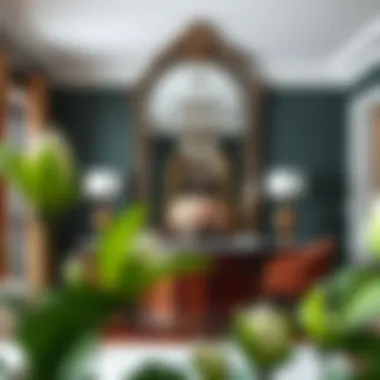
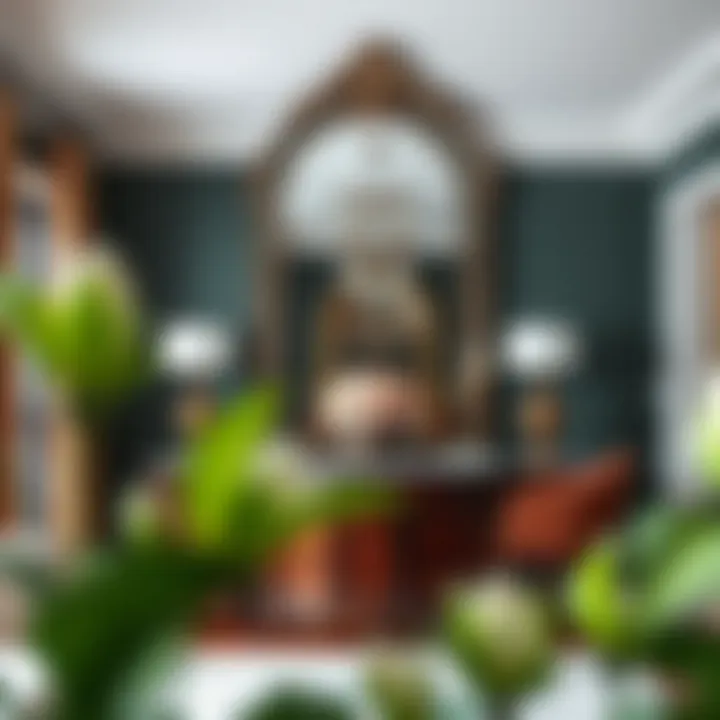
Choosing where to put mirrors is like picking the right spice for a dish—it can make or break the whole experience. The right placement goes beyond mere aesthetics; it can influence the feel and function of a space dramatically. This section emphasizes how thoughtful placement can elevate the visual appeal of any room, making spaces feel larger, lighter, and more inviting. Understanding the psychology behind spatial arrangements is an essential part of mastering interior design.
Entryways and Hallways
Entryways are often the first impression of your home. A well-placed mirror can amplify that impact. Positioning a mirror directly across from the entry door can create a sense of openness and welcome. It’s also a practical spot; many people like to take one last glance at themselves as they head out.
Consider a tall, slim mirror to maintain a balanced look, especially in narrow hallways. Hang it at eye level to ensure that it reflects light and lifelike images. Using mirrors here encourages movement, helping to visually extend an otherwise confined space.
- Key Benefits:
- Enhances light reflection, creating a brighter entry.
- Makes small spaces feel larger and more open.
- Provides a functional element for last-minute checks before leaving the house.
Living Areas and Dining Rooms
In living areas and dining rooms, mirrors can work wonders for ambiance. One effective strategy is to place a large mirror on a wall opposite a window. This not only reflects light but also views of the outdoors, bringing nature into your interiors. It creates depth by visually extending your space outward. Even in modest areas, a well-placed mirror can evoke a sense of grandeur.
On the flip side, you may opt for smaller mirrors as decorative accents, perhaps clustered together to form a gallery wall. These mirrors can add personality and playfulness while serving the more serious purpose of bouncing light around the space.
- Key Benefits:
- Creates an illusion of a larger space.
- Reflects natural light, enhancing the mood.
- Adds a stylish touch to the overall decor.
Bedrooms and Bathrooms
Mirrors play a crucial role in both bedrooms and bathrooms. In bedrooms, for instance, mirrors above dressers or nightstands can add elegance while providing practical functionality. Be mindful of placement; a mirror should never directly face the bed, as this can disrupt sleep according to some Eastern philosophies. Instead, angle it so it reflects something beautiful, whether it’s a piece of art or a calming view.
In bathrooms, mirrors are almost essential. A large mirror above the sink not only functions practically but can also enhance the space's visual appeal. Consider layered lighting around bathroom mirrors to create a softer ambiance that complements early morning routines or late-night relaxation.
- Key Benefits:
- Enhances functionality for daily grooming tasks.
- Promotes a tranquil atmosphere, especially when thoughtfully placed.
- Enhances the overall design aesthetic of the space.
Important Reminder:
When selecting placements for mirrors, consider the reflections they will cast. Ensure they reflect pleasant views rather than clutter, as this subtle detail can significantly affect the overall energy of your space.
Innovative Mirror Designs
More than just simple reflective surfaces, innovative mirror designs are reshaping interior spaces through creativity and function. Their capability to blend aesthetics with utility is worth delving into. Unique mirror designs can modify a room’s vibe, expanding horizons while serving critical roles in the functionality of spaces. With the growing trend of personalized interiors, these designs offer opportunities for homeowners and designers alike to create bespoke atmospheres.
Mirrored Furniture
Mirrored furniture has emerged as a game changer in contemporary interior design. From sleek coffee tables to elegant dressers, these pieces add a touch of glamour and sophistication. They stand not only as functional items but also as style statements. When placed strategically, mirrored furniture reflects light and color around a room, making spaces feel larger and more inviting.
Here are some notable benefits of incorporating mirrored furniture into your decor:
- Visual Space Expansion: By reflecting what’s in front of them, these pieces can trick the eye into thinking a room is much larger than it is. Perfect for smaller homes or areas that feel cramped.
- Light Enhancement: Mirrored surfaces enhance natural light. Positioning a mirrored table near a window can double the light, creating a bright, airy atmosphere.
- Versatility: Mirrored furniture fits various styles, from Art Deco to minimalist designs, making it adaptable to evolving tastes.
However, you should consider the maintenance that comes with mirrored furniture. Fingerprints and smudges can quickly accumulate, so regular cleaning is essential to keep the elegance intact. A soft cloth and a gentle glass cleaner are usually sufficient to restore shine without leaving scratches.
Artwork Incorporating Mirrors
Art is often a reflection of culture, emotion, and history. When mirrors are incorporated into artwork, they can create a dialogue with viewers, inviting them to engage on a deeper level. Incorporating mirrors into art can yield stunning focal points that captivate attention.
Some compelling aspects of artwork featuring mirrors include:
- Interactive Experience: Art with mirrors encourages viewers to see themselves within it, creating a personal connection. This interactive quality brings an additional layer of meaning.
- Layered Depth: Mirrors can transform two-dimensional works into three-dimensional experiences. By bouncing light and other elements, they create depth, adding visual intrigue.
- Unique Sculptural Forms: Artists often use mirrors in creative forms, from avant-garde installations to traditional pieces with a modern twist. This innovation pushes the boundaries of how art is perceived and appreciated.
As you contemplate adding mirrored artwork to your space, think about the surrounding decor. Mirrors can amplify the themes present in your room or beautifully contrast them. Moreover, be sure to consider the overall lighting, as natural light will drastically change how a piece appears throughout the day.
"Mirrors can do wonders in terms of enhancing perception, inviting engagement, and adding layers to both art and furniture. They’re underrated assets in interior design."
By exploring innovative mirror designs, homeowners and designers can elevate their spaces from ordinary to extraordinary. Such designs break conventional boundaries and allow for limitless creativity. The growing popularity of mirrored furniture and art reflects a broader trend in design toward personalization and imaginative expression.
For more insights on designing with mirrors, visit resources like Wikipedia and Britannica.
Cultural Significance of Mirrors
Mirrors have long been more than mere tools for reflection; they play a pivotal role in various cultures around the world. Their significance transcends aesthetic appeal and utility, often embedding themselves deeply in cultural beliefs, rituals, and artistic expressions. Understanding the cultural significance of mirrors not only broadens our appreciation for their design use but also emphasizes the intricate ways in which they influence spaces and the people in them.
Mirrors Across Different Cultures
From ancient civilizations to modern-day societies, mirrors have served multifaceted roles. In many cultures, mirrors were regarded as portals to other realms. For example, in ancient China, it was believed that mirrors could reflect not just appearances, but also spirits. Similarly, in medieval Europe, mirrors were often associated with the supernatural, utilized in divination practices to reveal hidden truths. Their placement and design were influenced by cultural beliefs, highlighting the importance of context in the way mirrors were used and understood.


- Eastern Traditions: In some Eastern cultures, mirrors are thought to ward off evil spirits. The concave mirrors used in Feng Shui aims to deflect negative energy, showcasing how mirrors are not just design elements but also tools of spiritual protection.
- Indigenous Communities: Various indigenous cultures have their own interpretations of mirrors, seeing them as representations of self-identity and community values. For instance, in some Native American tribes, polished stones functioned similarly to mirrors but were used in the context of introspection and connection to nature.
Symbolism and Beliefs Related to Mirrors
The symbolism associated with mirrors varies significantly across different cultures, often clustering around themes of reflection, truth, and duality. They serve as metaphors for broader philosophical inquiries, particularly concerning self-perception and authenticity.
"The mirror is a reflection of one's identity, shedding light on the unseen aspects of our being."
- Truth and Illusion: In Western tradition, the mirror is often seen as a symbol of truth. However, it also embodies illusion, as it can distort reality, making it a dual-purpose object. This paradox is explored in literature and art, calling into question what is real and what is merely a reflection.
- Ritualistic Contexts: In several cultures, mirrors are integral to rituals. The breaking of a mirror, for instance, is viewed as an omen of misfortune in some cultures. Conversely, in others, the act is seen as a way to break free from negative energies, showcasing unique interpretations of what mirrors represent in life and death.
In summary, the cultural significance of mirrors weaves a rich tapestry of meanings that bridge the gap between functionality and deeper resonances of self and perception. It invites homeowners, designers, and DIY enthusiasts to not just consider mirrors as decorative elements, but also as powerful tools that reflect the cultural narratives and histories of the spaces they occupy.
Maintenance and Care of Mirrors
Maintaining and caring for mirrors in an interior space is crucial not only for their appearance but also for their longevity. Mirrors serve both functional and aesthetic purposes; they reflect light, create the illusion of more space, and enhance overall décor. However, like anything of value in a home, they require proper attention to maintain their clarity and sparkle. Regular care and understanding of how to clean them based on their finish can save homeowners time and money in the long run while avoiding costly replacements.
Cleaning Techniques for Various Finishes
Different mirror finishes require distinct cleaning methods. Whether it’s a simple glass mirror, a decorative antique one, or a modern mirrored furniture piece, knowing the right approach can make all the difference.
- Standard Glass Mirrors: Use a soft, lint-free cloth. Spray a glass cleaner onto the cloth, not directly on the mirror, to avoid streaks. Gently wipe the surface in an S-shaped motion to ensure even coverage.
- Antique Mirrors: These often have a delicate surface that might be more prone to scratching. Here, it's advisable to use a mixture of water and vinegar, applying it with a soft microfiber cloth. Avoid abrasive materials entirely to keep the reflective coating intact.
- Mirrored Furniture: For pieces like a mirrored coffee table, dust regularly with a microfiber cloth to prevent scratches. For deeper cleans, a diluted soap solution can be employed, but always follow up with a damp cloth to avoid soap residue.
"Regular cleaning not only preserves the aesthetic quality but can also deter potential damage caused by dirt or grime."
Preventing Damage and Scratches
Prevention is indeed better than cure, especially when it comes to mirrors. Scratches can ruin the reflectivity and overall quality of a mirror, and preventing them requires a mindful approach to placement and maintenance.
- Appropriate Placement: Avoid placing mirrors in high-traffic areas where they may get bumped. Instead, install them in locations that allow for a clear view without interference.
- Handling with Care: When moving mirrors, always have someone assist you. Use padding or bubble wrap during transportation to keep the surface safe from physical damage.
- Routine Checks: Make it a habit to check for any cracks or damage regularly. Addressing small issues early can prevent bigger problems later on.
- Avoiding Harsh Chemicals: Many common cleaning products can cause more harm than good. Stick to pH-balanced cleaners or natural solutions, which help clean effectively without wear and tear on the mirror's surface.
Sustainability Considerations
In today’s world, sustainability isn’t just a buzzword; it's a necessity. When it comes to interior design, it’s crucial to think about how our choices impact the environment. Mirrors, while often overlooked, play a significant role in sustainability considerations. They are not merely decorative objects; their use can contribute to energy efficiency and responsible consumption.
Using mirrors effectively can maximize natural light in spaces, thereby reducing reliance on artificial lighting. Additionally, the right choice in materials can lead to reduced carbon footprints. Opting for brands that prioritize eco-friendly practices is becoming more prevalent. This choice not only helps in minimizing environmental impact but often leads to increased durability, implying a longer lifespan for the items purchased.
Eco-Friendly Mirror Options
When selecting mirrors with sustainability in mind, there are several aspects to consider:
- Material Choices: Look for mirrors that use recycled glass. The production process for recycled materials typically uses less energy and results in lower emissions than new materials. Bamboo frames can also be a wise choice as bamboo grows quickly and requires little water.
- Non-Toxic Finishes: Many modern mirrors come with frames finished in non-toxic paints and coatings. These options have a drastically lower impact on both indoor air quality and environmental degradation.
- Sourcing: Supporting local artisans or companies committed to sustainable practices can reduce transportation emissions and create a smaller environmental impact overall. Look for brands that tout sustainable sourcing or give back to the community.
"Choosing sustainable options is not just about reducing harm; it’s about contributing positively to our world."
Recycling and Repurposing Old Mirrors
Repurposing old mirrors is a creative and eco-friendly way to give them a new life instead of allowing them to end up in a landfill. Here are a few ideas to consider:
- Creative Wall Art: Old mirrors can be transformed into stunning wall art. With a bit of creativity, one can frame broken pieces or use them to create an artistic mosaic.
- Furniture Accents: If worn mirrors still have good integrity but lack style, consider using them as decorative elements on furniture. For example, mirrored table tops or drawer fronts can add elegance without the need for new materials.
- Functional Items: Mirrors can be converted into unusual home decor or functional items, like an outdoor table with mirror tops providing a reflection of the surroundings.
Additionally, it's worth remembering that some local charities or thrift stores may accept old mirrors. This not only gives your old piece a second life but also supports your community by providing affordable options for others.
Final Thoughts on Utilizing Mirrors
In the context of interior design, mirrors are not just objects reflecting images; they are powerful tools that can radically alter the atmosphere of a space. This article delves into the myriad ways mirrors can be employed to enhance both functionality and aesthetics within a home. The reflections of design become increasingly relevant as homeowners seek to create spaces that are not only beautiful but also serve practical purposes.
Balancing Functionality with Aesthetics
Finding the sweet spot between practicality and visual appeal is no small feat. With mirrors, this balance can be elegantly achieved. First off, consider what role the mirror serves. Is it merely decorative, or does it help to brighten up a dark corner? For instance, in a small living room, a strategically placed mirror can serve as a functional element that enlarges the visual space while also offering a stylish design element.
- Functional Aspects:
- Aesthetic Appeal:
- Light Reflection: Mirrors naturally amplify light, creating an airy ambiance. This is particularly beneficial in narrower spaces or rooms with limited windows.
- Depth Perception: By carefully positioning mirrors, a sense of depth can be created. This is circumstantial to the mirror's size and style, dictating the overall feel of the room.
- Style Expression: With countless styles available, from sleek modern to ornately vintage, mirrors can seamlessly integrate into any design narrative.
- Cohesion: Utilizing mirrors with a consistent design language throughout the space can forge a sense of unity, enhancing the overall interior theme.
Achieving harmony means questioning traditional norms and being open to experimenting. Imagine installing a large antique mirror in a minimalist setting—while it defies conventions, it also adds a layer of narrative and complexity.
Inspiration for Personal Spaces
Every home tells a story, and mirrors can amplify this narrative through unique design choices. They not only reflect but also enhance the emotions tied to personal experiences. Here are a few takes on how mirrors can inspire and transform personal spaces:
- Unique Customization: Choose mirrors that resonate with personal style. A circular, geometrically daring mirror can become a focal point, encouraging visitors to engage with its shape while also serving practical purposes.
- Storytelling through Placement: Consider displaying mirrors in unexpected locations, like near bookshelves or above a collection of framed photos. This positioning evokes a sense of continuity and personal expression.
- Play with Layers: Layering mirrors with other elements, like artwork or lighting fixtures, creates a multidimensional look while also providing opportunities for reflection and intrigue.
"Mirrors do not just reflect a room; they reflect the soul of the home itself." - Anonymous
As you navigate the fascinating world of interior design, remember the profound impact mirrors can have in shaping not only spaces but also emotions. Keep exploring, experimenting, and let your personal touch shine through.







